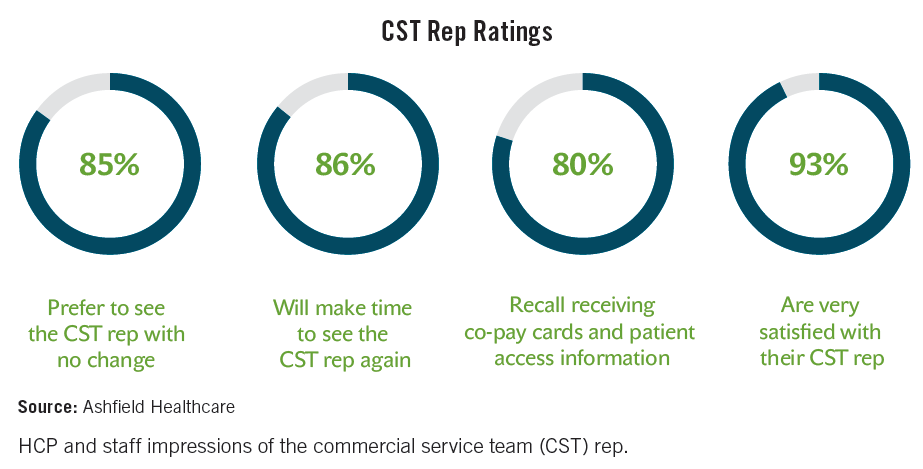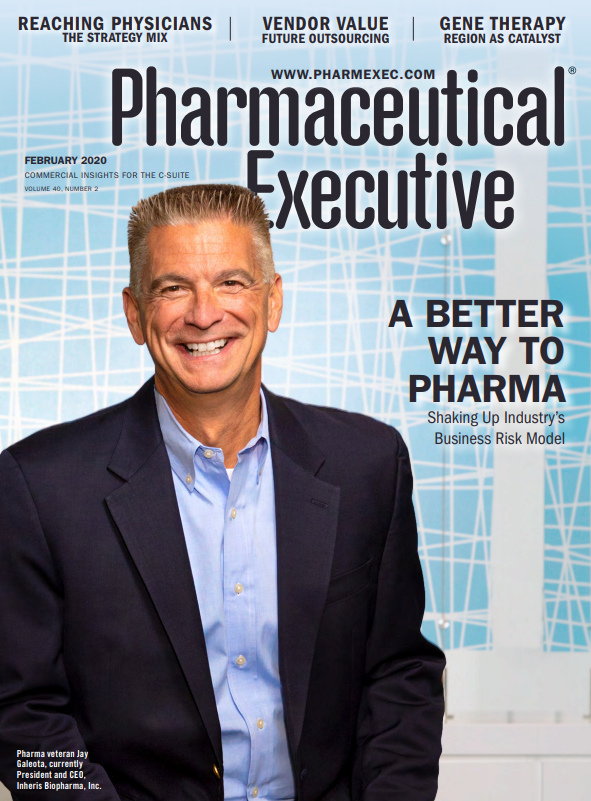Using Service to Drive Commercial Value
Pharmaceutical Executive
One ‘team’ model’s advantages in brand outreach and awareness.
One ‘team’ model’s advantages in brand outreach and awareness
Accessing and impacting healthcare professionals (HCPs) is a complicated process, yet at its core it is still a critical driver of healthcare delivery. To optimize these efforts, the industry is using sophisticated sales analytics and planning to drive physician promotion through multiple channels and models. All the while it is striving to develop the flexibility and responsiveness needed to target and adapt the promotional mix in response to these tracking analytics. A commercial field service model, developed in partnership with major pharmaceutical companies, has morphed and developed to be a significant commercial program in delivering compelling value and return on investment (ROI) in support of key brands across their life cycle.
Why a service team-and why now?
The Commercial Service Team (CST) field model was developed to address commercial challenges in three key areas: loss of exclusivity (LOE) brands, brand launch support, and amplifying growth brands. With LOE brands, the challenge is to slow down the sales bell curve drop-off as these brands lose exclusivity and awareness, since they still tend to represent significant revenue potential, be beneficial to patient wellness, and be better known to prescribers than their generic counterparts.
Field sales teams representing launch or growth brands are often not able to get their brand messaging to resonate with target accounts as cost effectively as desired, so amplification of this promotional effort through the service channel is an ideal solution. Only reaching the prescribing HCP and retail pharmacy with a traditional field sales rep to harvest the LOE brand potential or reinforce launch and growth brand messaging is not always practical.
Not wishing to leave these end-of-life brands to sell by inertia along the diminishing-returns bell curve, or lose the upside potential in launch and growth brands, the industry has looked to other promotional methods. Some companies chose to use non-personal multichannel outreach exclusively for these products. Others sought to incorporate a field solution that would maintain brand awareness at a more effective cost point.
The CST model can be considered a solution to these challenges. This non-clinical model maintains face-to-face contact and promotional messaging on brands that could otherwise go unrepresented. It deploys a full-office engagement team that complements existing commercial channels by connecting brands to patients and their HCPs.
These teams provide savings cards, samples, patient starter kits, payer access information, product training, and other support materials. In so doing, the model offers brand engagement at 50% to 75% less cost than a traditional field sales representative, and maintains the face-to-face contact that cuts outside the digital noise accompanying many multichannel campaigns.
How it works
The CST model can be tailored to meet a variety of promotional needs focused on providing non-clinical product support and pull-through. CST reps are fully trained within compliance standards to service physician offices with samples, literature, reimbursement and access information, and copay cards. Many teams are also tasked with demonstrating to the staff the correct administration of the brand’s delivery mechanism, as well as providing information on the patient support programs available in order to improve adherence. To maximize customer coverage with optimal frequency, the typical service territory covers a 50 to 75 mile radius, and the model is most effective when these territories cover metropolitan statistical areas.
Commercial service reps come from many different backgrounds. They are college educated, but do not need previous pharma sales experience or a scientific degree. Rather, individuals are hired based on their service mindset (i.e., hospitality, retail expertise) and ability to build rapport and create opportunities for discussion, and to do so repeatedly and consistently to achieve daily target goals. Inherently, they have a different motivational driver than field sales reps, as they are expected to reach daily target goals of office calls and distribution of samples and/or non-sample resources, as well as being knowledgeable in managed care to support patients and their use of the brand.
Each deployment is based upon the needs of the client’s particular brand promotion, with flexibility of implementation the key. Some teams cover LOE brands. Some will supplement field coverage of launch or growing brands to heighten awareness by providing samples or managed care information while the sales rep concentrates on clinical messaging. Some handle vacancy management or whitespace promotion. The ultimate goal is to optimize face-to-face interactions with prescribers and key influencers in order to make a difference to the patient and thereby maintain or increase script writing.
Since this is a model based on core activities, customers are targeted based on where they can be optimally reached (group practice prioritized over solo practitioner). Commercial service reps can support upwards of 20 or more brands across multiple portfolios in their bag, but will only address the designated brands targeted for that specific account. In some cases, the CST rep supports brands from more than one manufacturer in the same call, based on the targeting and allocations for that account. One to six brands are the average representations in a call, although as many as 10 brands can be represented. Average account calls per day range from 15 to 20 over 220 days in the field, versus 190 days in the field for traditional sales reps.
On paper, the CST is a very attractive model to pursue-in practice, even more so when one considers the impact these service visits to the office can have in terms of brand awareness at a significantly lower cost than traditional sales visits.
Why it works
The CST model is effective because it offers patient support service to the physician and staff in a quick face-to-face visit (average of two minutes). While the field sales team works to deliver messaging and create brand awareness, it may be necessary for them to see a prescriber 12 times before the brand is remembered. In the case of LOE brands typically having a strong clinical voice already, or in other brands where samples are needed, the CST rep is offering information to help better serve patients. The HCP tends to be more receptive to this type of rep interaction.
Although HCPs find the service provided to them and their staff by the CST rep inherently appealing, the CST model requires laser-focused back office analytics and an innate flexibility to reach program goals. All reps are tied into the CRM system, which draws upon leading-edge targeting technology based on the criteria of high prescribers, total prescriptions (TRx), brand loyalty, and other segmentations. The rep records activity at each account, which, in turn, drives weekly or monthly analytical reports to measure progress and keep the program effective at all times. Initial call activity is built in tandem with an analytics team and the pharmaceutical company, based on prior experience, goals, and industry-specific data. The technology platform allows for program parameters to be changed in real time to optimize the rep’s call plan.
Creating commercial value
Since its inception, the CST model has delivered strong impact on TRxs. One nationwide program representing an LOE brand showed TRx increases ranging from 46% to 74%, delivering a marketing ROI of 75%. In a launch brand program, where the CST was tasked with elevating perception of the brand, the team delivered a +2.1 TRx impact among high-value customers. When surveyed, 93% of the customers reached were extremely satisfied with the CRT rep. Eighty percent recalled receiving copay and/or access information and 86% said they would see the CRT rep in the future (see chart below). Other multi-year programs have shown ROI results ranging from 3:1 to 5:1.

As discussed, the innovations offered by the CST model are resolving some of the complications the industry faces in physician reach while generating strong commercial value. It is a highly nuanced model, relying on experience, collaboration, and a flexible responsiveness to market conditions. Certainly not a one-size-fits-all program, the unique requirements of each deployment must be addressed with the appropriate call plans and attracting and retaining the right talent-individuals with a keen appreciation of service and all that it entails. These, along with the ability to leverage technology and rely on a laser-targeted back office to support the call plans, can continue to drive the commercial success of this model.
Whether the team is supporting the brand by maintaining awareness and delivering information to the office to assist in adherence, or opening doors for the field sales rep, the commercial service team can be a critical component of a commercialization strategy.
Mike Stout is President, Ashfield Commercial, US, part of UDG Healthcare plc

The Misinformation Maze: Navigating Public Health in the Digital Age
March 11th 2025Jennifer Butler, chief commercial officer of Pleio, discusses misinformation's threat to public health, where patients are turning for trustworthy health information, the industry's pivot to peer-to-patient strategies to educate patients, and more.
Navigating Distrust: Pharma in the Age of Social Media
February 18th 2025Ian Baer, Founder and CEO of Sooth, discusses how the growing distrust in social media will impact industry marketing strategies and the relationships between pharmaceutical companies and the patients they aim to serve. He also explains dark social, how to combat misinformation, closing the trust gap, and more.